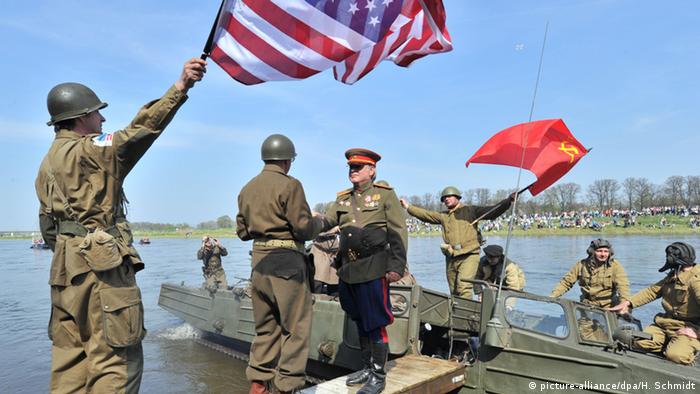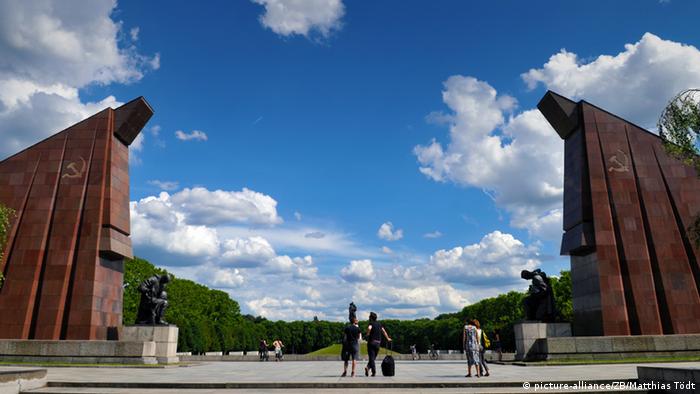On 8. May 1945, the unconditional surrender of Hitler Germany. The Second world war in Europe was over. Memorials in Germany are reminiscent of the liberation by the allies.
-

more
In the footsteps of the liberators
Battle in the hurtgen forest
Close to Aachen, the US armed forces resulted in several fierce battles against the German Wehrmacht. Still can be found in the huertgen forest relics of these battles, from the autumn of 1944 to early 1945, and lasted some of the longest and most important battles on German territory. The hürtgen forest is now part of the “Liberation Route Europe”, which is reminiscent of the way the allied forces.
-

In the footsteps of the liberators
Bridge of Remagen
On 7. In March 1945, the capture of the US soldiers, the surprisingly still intact Remagener railway bridge in Cologne, Germany. Thousands of soldiers have to cross over them for the first time, the Rhine, the “miracle of Remagen” in the history of war. Bomb attacks of the Germans bring the bridge ten days later, to collapse. Today, a peace Museum is located in the bridge rest.
-

In the footsteps of the liberators
Commonwealth war cemetery in the reichswald forest
While the US army transported their Fallen home, find the dead of the British armed forces on 15 cemeteries in Germany. The largest Commonwealth war graves cemetery is the British cemetery in the reichswald forest, close to the Dutch border. The 7654 dead around 4000 pilots and passengers of combat aircraft, including many Canadians.
-

In the footsteps of the liberators
Memorial Seelow Heights
In the East, the Red army opened on 16. April 1945, their last major offensive: With a devastating barrage in the dawn heights of the thrust in the direction of Berlin at the Seelow. Of 900,000 Soviet soldiers against 90,000 in German. The memorial to know about the largest battle of the Second world war, on German soil, and is reminiscent of the tens of thousands of dead.
-

In the footsteps of the liberators
“Elbe Day” in Torgau
25. April 1945, meeting for the first time Russians and Americans at Torgau on the Elbe river. The gap between East and West is closed in Front. The end of the war draws nearer, the handshake of Torgau world famous. At the event, the Saxon town remembered annually with a commemorative event of the “Elbe Day”, in the episodes of the encounter to be adjusted.
-

In the footsteps of the liberators
German-Russian Museum Berlin-Karlshorst
In the officer’s casino in Berlin-Karlshorst the German Wehrmacht signed in the night from 8. 9. In may 1945, the unconditional surrender. The Museum presents today, in the surrender room of the deed, which was drawn up in three language versions: English, Russian, German. Also the theme of the permanent exhibition of the war of extermination against the Soviet Union from 1941.
-

In the footsteps of the liberators
Soviet memorial in Treptower Park
The sheer size of the Treptow memorial is impressive. At approximately 100,000 square feet of space in the memorial with the soldier cemetery. It is built after the end of the Second world war, to commemorate the battle of Berlin fallen red army soldiers. Two stylised Soviet flags made of red granite, the Portal to the honor grove with the graves.
-

In the footsteps of the liberators
Potsdam conference in Cecilienhof Palace
After the Takeover of the government days in the summer of 1945, the three main Cecilienhof Palace allies in a castle in Potsdam. Josef Stalin, Harry S. Truman, and Winston Churchill to lead the delegations, which advised on the post-war order in Europe. At the end of the division of Germany into four zones of occupation.
-

In the footsteps of the liberators
The allied Museum in Berlin-Dahlem
Berlin is divided in 1945 into four sectors. The centre of the US-American armed forces is the district of Zehlendorf. The former cinema “Outpost Theatre” is now part of the allied Museum. The exhibition spans the arc from the first years of occupation in West Berlin, the airlift and the Cold war to the withdrawal of the Americans in 1994.
-

In the footsteps of the liberators
Schönhausen Palace in Berlin
In 1990, the Prussian castle, the scene of the “Two-plus-Four talks” between the two German States and the victorious powers USA, great Britain, France and the Soviet Union. Prepare the German reunification. On the site, with memorial boards provide information about how the Second world war took place here, finally.
Author: Frederike Müller
-

more
In the footsteps of the liberators
Battle in the hurtgen forest
Close to Aachen, the US armed forces resulted in several fierce battles against the German Wehrmacht. Still can be found in the huertgen forest relics of these battles, from the autumn of 1944 to early 1945, and lasted some of the longest and most important battles on German territory. The hürtgen forest is now part of the “Liberation Route Europe”, which is reminiscent of the way the allied forces.
-

In the footsteps of the liberators
Bridge of Remagen
On 7. In March 1945, the capture of the US soldiers, the surprisingly still intact Remagener railway bridge in Cologne, Germany. Thousands of soldiers have to cross over them for the first time, the Rhine, the “miracle of Remagen” in the history of war. Bomb attacks of the Germans bring the bridge ten days later, to collapse. Today, a peace Museum is located in the bridge rest.
-

In the footsteps of the liberators
Commonwealth war cemetery in the reichswald forest
While the US army transported their Fallen home, find the dead of the British armed forces on 15 cemeteries in Germany. The largest Commonwealth war graves cemetery is the British cemetery in the reichswald forest, close to the Dutch border. The 7654 dead around 4000 pilots and passengers of combat aircraft, including many Canadians.
-

In the footsteps of the liberators
Memorial Seelow Heights
In the East, the Red army opened on 16. April 1945, their last major offensive: With a devastating barrage in the dawn heights of the thrust in the direction of Berlin at the Seelow. Of 900,000 Soviet soldiers against 90,000 in German. The memorial to know about the largest battle of the Second world war, on German soil, and is reminiscent of the tens of thousands of dead.
-

In the footsteps of the liberators
“Elbe Day” in Torgau
25. April 1945, meeting for the first time Russians and Americans at Torgau on the Elbe river. The gap between East and West is closed in Front. The end of the war draws nearer, the handshake of Torgau world famous. At the event, the Saxon town remembered annually with a commemorative event of the “Elbe Day”, in the episodes of the encounter to be adjusted.
-

In the footsteps of the liberators
German-Russian Museum Berlin-Karlshorst
In the officer’s casino in Berlin-Karlshorst the German Wehrmacht signed in the night from 8. 9. In may 1945, the unconditional surrender. The Museum presents today, in the surrender room of the deed, which was drawn up in three language versions: English, Russian, German. Also the theme of the permanent exhibition of the war of extermination against the Soviet Union from 1941.
-

In the footsteps of the liberators
Soviet memorial in Treptower Park
The sheer size of the Treptow memorial is impressive. At approximately 100,000 square feet of space in the memorial with the soldier cemetery. It is built after the end of the Second world war, to commemorate the battle of Berlin fallen red army soldiers. Two stylised Soviet flags made of red granite, the Portal to the honor grove with the graves.
-

In the footsteps of the liberators
Potsdam conference in Cecilienhof Palace
After the Takeover of the government days in the summer of 1945, the three main Cecilienhof Palace allies in a castle in Potsdam. Josef Stalin, Harry S. Truman, and Winston Churchill to lead the delegations, which advised on the post-war order in Europe. At the end of the division of Germany into four zones of occupation.
-

In the footsteps of the liberators
The allied Museum in Berlin-Dahlem
Berlin is divided in 1945 into four sectors. The centre of the US-American armed forces is the district of Zehlendorf. The former cinema “Outpost Theatre” is now part of the allied Museum. The exhibition spans the arc from the first years of occupation in West Berlin, the airlift and the Cold war to the withdrawal of the Americans in 1994.
-

In the footsteps of the liberators
Schönhausen Palace in Berlin
In 1990, the Prussian castle, the scene of the “Two-plus-Four talks” between the two German States and the victorious powers USA, great Britain, France and the Soviet Union. Prepare the German reunification. On the site, with memorial boards provide information about how the Second world war took place here, finally.
Author: Frederike Müller